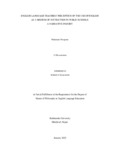
Please use this identifier to cite or link to this item:
https://hdl.handle.net/20.500.14301/516Full metadata record
| DC Field | Value | Language |
|---|---|---|
| dc.contributor.author | Neupane, Maniram | - |
| dc.date.accessioned | 2025-06-11T12:20:18Z | - |
| dc.date.available | 2025-06-11T12:20:18Z | - |
| dc.date.issued | 2025-01 | - |
| dc.identifier.citation | Neupane, M. (2025). English language teachers' perception of the use of English as a medium of instruction in public schools: A narrative inquiry. | en_US |
| dc.identifier.uri | https://hdl.handle.net/20.500.14301/516 | - |
| dc.description.abstract | This research aims to explore English language teachers' experiences and perceptions of implementing the English language as a medium of instruction in secondary-level (9-12) classes in Nepal. The study focuses on the challenges and impact of implementing EMI in particular. The narrative inquiry method was employed within the framework of the interpretative research paradigm. Similarly, I aligned social constructivist learning theory and communicative language learning theory to study and analyze the narratives of teachers' experiences of teaching English through the English medium. When talking about ELT, so many methods and techniques, such as; the GT method, audiolingual method, nativist approach, etc. have been brought into practice. Within Nepal, some schools and students also preferred EMI, whereas most of the students and teachers liked and demanded the use of the mother tongues of the students. In reality, teaching and learning focus should be on the students and they should understand the content we deliver. Not only this, but our language, culture, and identity should also be preserved, and we should be aware that we may not be lost after some decades. Taking these issues in mind, I have come to conclude that in most Nepalese public school contexts, switching the code in the classrooms is the better pedagogical strategy in three ways; a) by making the learners learn easily with a clear concept of the content, b) by reducing costs for materials and training for implementing the EMI, and, most importantly, c) by preserving local language and culture of the people, ultimately their identity. I further emphasize that in the course of teaching English as an FL/SL in Nepal, the latter strategies (switch the code and preserve our identity) are more economical, effective, and fruitful in clarifying the content as well as in preserving people's language, culture, and identity. Therefore, regarding the use of EMI, I focus on the 'Learners' Preference Theory (LP Theory)' in the context of Nepalese classrooms. | en_US |
| dc.language.iso | en | en_US |
| dc.publisher | Kathmandu University School of Education | en_US |
| dc.title | English Language Teachers' Perception of the Use of English as a Medium of Instruction in Public Schools: A Narrative Inquiry. | en_US |
| dc.type | Dissertation | en_US |
| local.school.name | SOED | en_US |
| local.school.department | DOLE | en_US |
| local.school.program | Master of Philosophy (MPhil) in English Language Education | en_US |
| local.school.level | M.Phil. | en_US |
| Appears in Collections: | Dissertation | |
Files in This Item:
| File | Description | Size | Format | |
|---|---|---|---|---|
| Maniram Neupane.pdf | 1.34 MB | Adobe PDF |  View/Open |
Items in DSpace are protected by copyright, with all rights reserved, unless otherwise indicated.